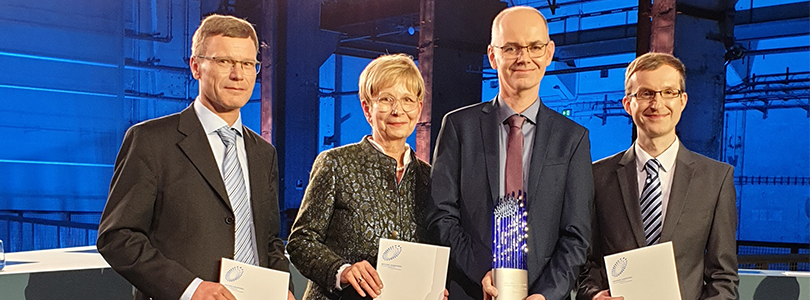Content
"Level never seen before": 2022 Deutscher Zukunftspreis award fort high-tech microscope

DPMA-Präsident Cornelia Rudloff-Schäffer with Dr. Thomas Kalkbrenner, Dr. Jörg Siebenmorgen and Ralf Wolleschensky
The jury selects the team proposed by the German Patent and Trade Mark Office – DPMA President congratulates scientists of ZEISS Research Microscopy Solutions on being recognised by the Federal President
Press release of 26 October 2022
Munich. With a high-resolution 3D microscope, they generate images on an unprecedented scale: The President of the German Patent and Trade Mark Office (DPMA), Cornelia Rudloff-Schäffer, has congratulated Dr Thomas Kalkbrenner, Dr Jörg Siebenmorgen and Ralf Wolleschensky of ZEISS Research Microscopy Solutions in Jena on being presented with the Deutscher Zukunftspreis award by Federal President Frank-Walter Steinmeier. "We are very pleased that the jury has selected the innovation proposed by our office for this prestigious award,” the DPMA President said and added: “More than almost any other instrument, the microscope has contributed to promoting research and innovation. With their new technology, the scientists have improved microscopy to a level never seen before. This allows new, ground-breaking findings and innovations to be made which benefit people, including a lot of very sick people."
Federal President Frank-Walter Steinmeier had awarded the prize in a solemn ceremony at Kraftwerk Berlin. The event was broadcast near live on German TV channel ZDF.
At the award ceremony, the team presented the new, high-resolution 3D fluorescence microscope for examining biological probes themselves. The microscope minimises the undesirable effect of so-called phototoxicity, that is the damage inflicted on living organisms by the absolutely necessary light. Cells can thus be observed over longer periods of time without results being distorted. The device is also easy to operate and enables the continued use of established sample preparations. It also allows rapid analysis of a large number of samples (high-throughput screening) and makes it easy for non-academic staff to carry out experiments.
Two other teams were also nominated for the Deutscher Zukunftspreis award:
Stefan Vilsmeier and Claus Promberger of Munich-based Brainlab AG and Prof Cordula Petersen of the University Medical Center Hamburg-Eppendorf have developed a system for high-precision patient positioning and monitoring for radiotherapy – such as for lung cancer. The new “ExacTrac Dynamic” system monitors the patient's movement and the respiration-induced tumour motion (tracking). For this purpose, measurement data from a 3D surface camera and a thermal sensor are combined with stereoscopic real-time X-ray data. Software calculates a correlation model of the internal and surface movement. This allows the system to position the X-ray beam precisely at the tumour. Damage to the surrounding healthy tissue is thus minimised. This innovation had also been proposed by the DPMA to the jury.
Thomas Speidel and Dr Thorsten Ochs of ads-tec Energy GmbH in Nürtingen and Stefan Reichert of the Fraunhofer Institute for Solar Energy Systems ISE in Freiburg use their “ChargeBox” to enable nationwide, ultra-fast charging of electric vehicles (EV) even in the existing, often power-limited grid. For this purpose, battery systems are used as buffer storage between low-voltage grid and vehicle. EV charging is thus possible even in city centres and remote rural areas with low-power grid connections.
The Deutscher Zukunftspreis award, the Federal President’s Award for Innovation in Science and Technology, is presented annually and comes with prize money of 250,000 euros.
The German Patent and Trade Mark Office
Inventiveness and creativity need effective protection. The DPMA is the German centre of expertise for all intellectual property rights – patents, utility models, trade marks and designs. As the largest national patent office in Europe and the fifth largest national patent office in the world, our office stands for the future of Germany as a country of inventors in a globalised economy. Its staff of just under 2,800 at three locations – Munich, Jena and Berlin – provide services to inventors and companies. They implement federal innovation strategies and develop the national, European and international protection systems further.
pictures: DPMA/Pöhlmann, Deutscher Zukunftspreis Ansgar Pudenz
Last updated: 26 October 2022


Not only protecting innovations
Social Media